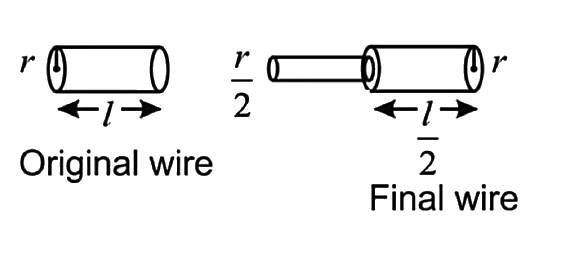If the resistance of wire is 1Ω . If the radius of wire is halved then the new resistance will be:
2 R
16 R
8 R
4 R
The correct Answer is:B
To solve the problem, we need to understand how the resistance of a wire changes when its radius is altered. The resistance R of a wire is given by the formula:
R=ρLA
where:
- R is the resistance,
- ρ is the resistivity of the material,
- L is the length of the wire,
- A is the cross-sectional area of the wire.
Step 1: Initial Conditions
Let the initial resistance R=1Ω. The initial radius of the wire is R and the length is L. The cross-sectional area A can be expressed as:
A=πR2
Step 2: Change in Radius
If the radius of the wire is halved, the new radius R′ becomes:
R′=R2
Step 3: Calculate New Area
The new cross-sectional area A′ after the radius is halved is:
A′=π(R′)2=π(R2)2=πR24=A4
Step 4: Volume Conservation
Since the volume of the wire remains constant, we can equate the initial volume V and the final volume V′:
V=A⋅L=πR2L
V′=A′⋅L′=A4⋅L′
Setting these equal gives:
πR2L=A4⋅L′
Substituting A=πR2:
πR2L=πR24⋅L′
Step 5: Solve for New Length
Cancelling πR2 from both sides:
L=L′4
Thus, we find:
L′=4L
Step 6: Calculate New Resistance
Now we can find the new resistance R′:
R′=ρL′A′=ρ(4L)A4=4ρLπR24=16ρLπR2
Step 7: Relate to Initial Resistance
Since R=ρLA, we can express R′ in terms of R:
R′=16⋅ρLA=16R
Conclusion
Therefore, the new resistance when the radius of the wire is halved is:
R′=16Ω
Final Answer
The new resistance will be 16R.
---
- R is the resistance,
- ρ is the resistivity of the material,
- L is the length of the wire,
- A is the cross-sectional area of the wire.
Let the initial resistance R=1Ω. The initial radius of the wire is R and the length is L. The cross-sectional area A can be expressed as:
If the radius of the wire is halved, the new radius R′ becomes:
The new cross-sectional area A′ after the radius is halved is:
Since the volume of the wire remains constant, we can equate the initial volume V and the final volume V′:
V′=A′⋅L′=A4⋅L′
Cancelling πR2 from both sides:
Now we can find the new resistance R′:
Since R=ρLA, we can express R′ in terms of R:
Therefore, the new resistance when the radius of the wire is halved is:
The new resistance will be 16R.
Similar Questions
Resistivity of a material of wire is 3⋅10−6Ω−m and resistance of a particular thickness and length of wire is 2Ω. If the diameter of the wire gets doubled then the resistivity will be
View SolutionThe resistance of a wire is 10Ω. Its length is increased by 10% by stretching. The new resistance will now be
View SolutionThe resistivity of a wire
View SolutionWhen the resistance of copper wire is 0.1Ω and the radius is 1mm, then the length of the wire is (specific resistance of copper is 3.14×10−8ohm×m)
View SolutionA wire has a resistance of 10Ω. It is stretched by 1/10 of its original length. Then its resistance will be
View SolutionA metal wire has a resistance of 35Ω. If its length is increased to double by drawing it, then its new resistance will be
View SolutionIf a wire of resistance R is melted and recasted in to half of its length, then the new resistance of the wire will be
View SolutionTwo wires A and B of equal masses and of the same material are taken. The diameter of wire A is half the diameter of wire B. if the resistance of wire A is 24Ω, calculate the resistance of wire B.
View SolutionA wire of length l has a resistance R. If half of the length is stretched to make the radius half of its original value, then the final resistance of the wire is

View SolutionTwo resistances are joined in parallel whose resultant is 6/8ohm. One of the resistance wire is broken and the effective resistance becomes 2Ω . Then the resistance in ohm of the wire that got broken was
View Solution